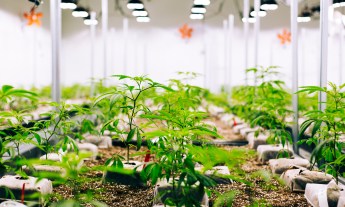
With so many different milk options at our fingertips, making eco-conscious choices at the grocery store can be challenging.
From plant and nut-based milks to dairy, we — sustainability researchers at Curtin University in Australia — have gathered the evidence and crunched the numbers to help you choose more planet-friendly options.
Any plant-based milk — whether it’s made from beans, nuts or seeds — has a smaller impact than dairy milk when it comes to water and land use, as well as carbon emissions.
In fact, a 2018 study estimated that dairy milk is around three times more greenhouse gas emission-intensive than plant-based milks. What’s more, dairy generally requires nine times more land than any of the plant-based alternatives. Every liter of cow’s milk uses 8.9 square meters per year, compared to 0.8 for oat, 0.7 for soy, 0.5 for almond and 0.3 for rice milk.
Water use is similarly higher for cow’s milk: 628 liters of water are used to produce every liter of dairy, compared to 371 for almond, 270 for rice, 48 for oat and 28 for soy milk.
Nut milks
Milk can be made from almost any tree nuts, but almond, hazelnut and coconut are among the most popular. Not only do nut milks generally require smaller land areas to produce than dairy milk, their trees absorb carbon and produce useful woody biomass at the end of their lives. Still, there are vast differences in the geographical conditions where nut trees are grown.
Almond milk
Compared to other plant-based options, almond milk’s water use is much higher and largely depends on freshwater irrigation. One kernel of California almond requires 12 liters of water, which raises serious sustainability questions about industrial almond production in water-scarce areas.
However, the biggest environmental concern in the US is the harm it poses to bees. First, almond trees need cross-pollination — some of this happens naturally, and some of it commercially, meaning beekeepers deliberately transport hives into growing fields. During this process, bees can be exposed to pesticides like glyphosate. Second, intensive industrial almond production can drastically transform nature’s fragile ecosystems and make bees’ natural habitats less inviting.
In Australia, where almond orchards are smaller and less industrialized, bees do not experience the same problems. Still, millions of bees are needed to help produce almonds, and fires, drought, floods, smoke and heat damage all threaten their health and survival.
Coconut milk
The environmental performance of coconut milk is generally good – coconut trees use significantly less water than dairy cows, and they also absorb carbon dioxide.
However, because coconuts are grown only in tropical areas, there is limited land area where they thrive. That means large-scale industrial production of coconut milk encroach on wildlife habitat when producers expand their operations. Increasing global demand for coconut milk is likely to put further pressure on the environment and wildlife in these areas.
There are also labor issues associated with coconut production in low- and middle-income countries like Indonesia, India and the Philippines, where coconut pickers are sometimes paid less than a dollar a day (to support fair wages, look for certified Fair Trade coconut products.).
Hazelnut milk
Hazelnut trees are cross-pollinated by wind, which carries airborne dry pollen between neighboring plants — this is a better option for the environment, and it also means bees don’t have to be brought in and potentially exposed to pesticides. Hazelnuts also grow in areas with higher rainfall in Southern Europe and North America, which means they demand significantly less irrigated water than almond trees.
Although the demand for hazelnut milk is on the rise, hazelnut cultivation has not yet been subjected to intensive large-scale operations.
Legume milks
All legumes are nitrogen-fixing plants, which means bacteria in plant tissue produce nitrogen, improving soil fertility and reducing the need for fertilizers. Legumes are also more water-efficient compared to almonds and dairy.
Soy milk
Soy milk has good environmental performance in terms of water use and carbon emissions. However, as the demand for soy grows, deforestation and displacement of small farmers are becoming growing problems.
The US and Brazil are the biggest suppliers of soybeans, and a significant share are used as livestock feed. In theory, an overall reduction in the demand for meat and animal-based foods — a major source of CO2 emissions — could also decrease the need to produce soybeans for animal feed.
Hemp milk
The environmental benefits of hemp milk make it a game-changer. Its seeds are processed for oil and milk, and the plant itself has multiple uses. All of its parts can be used — as construction material, textile fibers, pulp, paper or hemp-based plastics.
Hemp (technically not a legume but with the same nitrogen-fixation properties) requires more water than soy, but less than almond and dairy. Its roots grow deep, which improves the soil structure and reduces the presence of fungi. It’s also resistant to diseases and creates weed-suppressing shade, which reduces the need for herbicides and pesticides.
Grain milks
Rice and oat are two of the most popular plant-based milks. However, they require large amounts of land and water.
Rice milk
Rice milk has a large water footprint and is associated with higher greenhouse gas emissions compared to the other plant-based milks. That’s because rice needs to be grown in standing water, and rice paddies are full of methane-producing bacteria.
In some cases, rice milk has been found to contain dangerous levels of arsenic, which is a naturally occurring element found in our water and soil. Applying fertilizers to boost rice yields can also pollute nearby waterways.
Oat milk
Currently grown in Canada and the US, most oat operations are large-scale monoculture, which means it’s the only type of crop grown in a large area. This practice depletes the soil’s fertility, limits the diversity of insects, and increases the risk of diseases and pest infection. But since oats are already mass produced on allocated land, it’s not a major driver of deforestation like other crops.
Oats are typically grown with glyphosate-based pesticides, which can cause glyphosate-resistant plant, animal and insect pathogens to proliferate. Similar to soy, the bulk of oat production is used for livestock feed rather than milk, so any reduction in the demand for animal-based foods would likely decrease oat cultivation and its environmental impact.
Here are 5 things to consider when choosing a milk
If you’re trying to reduce the environmental footprint of the milk you drink, a good first step is to replace dairy milk with plant-based options. When you do, keep this advice in mind:
1. Say goodbye to pesticides
Organic versions of plant-based milks are better for the environment because they typically use fewer chemical fertilizers, are free from pesticides and herbicides, and put less pressure on the soil.
2. Add up the additives
Keep in mind that any milk additives — like vitamins, flavorings or sweeteners — have their own footprint that should be considered too.
3. Consider the packaging
Buying milk packaged with recycled materials can help reduce your impact. For example, plastic packaging represents 45 percent of the greenhouse gas emissions of California’s almond milk.
4. Don’t waste what you buy
Like other kinds of food waste, throwing away milk has a big environmental impact because it means all the animals, land, water and energy used to produce it are ending up down the drain.
5. Diversify your milks
Shifting to only one plant-based option — even if it’s more environmentally-friendly than dairy milk — means the market demand can become overexploited and have downstream consequences.
A version of this article first appeared in The Conversation.
Watch this TED-Ed Lesson on the future of agriculture now:















